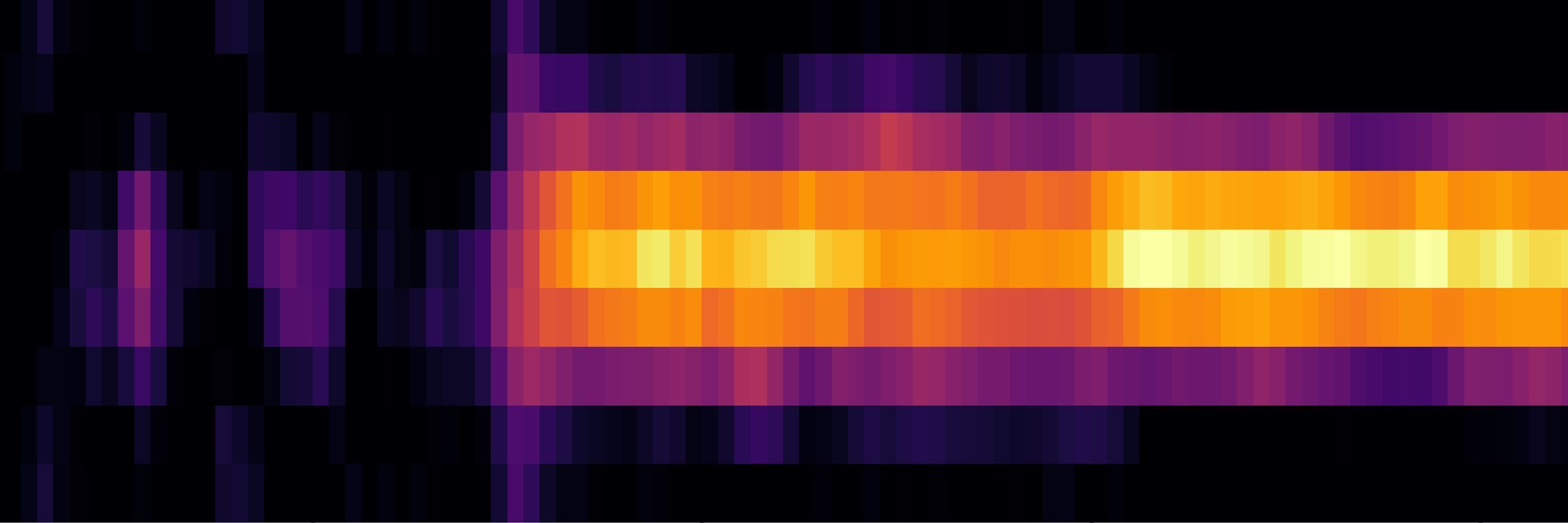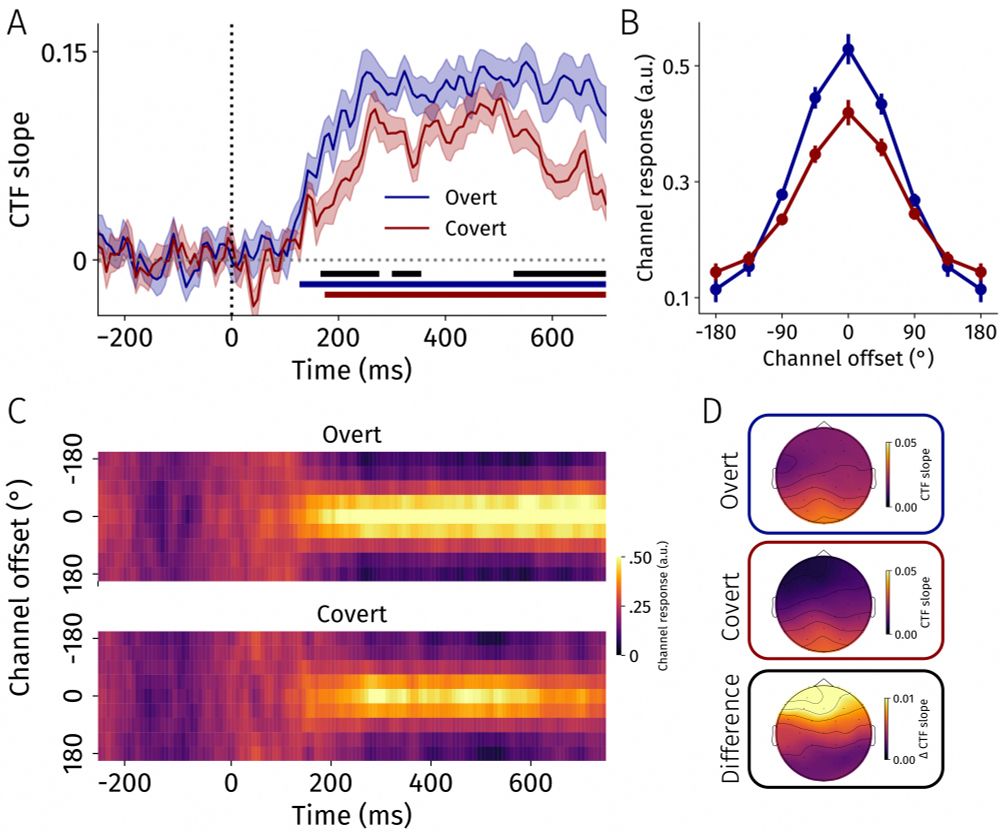
Damian Koevoet
@dkoevoet.bsky.social
PhD Candidate interested in visual attention and memory | Utrecht University | AttentionLab @attentionlab.bsky.social
Highlighting a supplementary analysis we added: Prior work showed that cross-decoding asymmetries can sometimes be driven by SNR differences between conditions instead of 'true' neurocognitive effects. We simulated EEG data and showed that SNR is unlikely to account for our cross-decoding results.

October 24, 2025 at 8:35 AM
Highlighting a supplementary analysis we added: Prior work showed that cross-decoding asymmetries can sometimes be driven by SNR differences between conditions instead of 'true' neurocognitive effects. We simulated EEG data and showed that SNR is unlikely to account for our cross-decoding results.
We analyzed pupil size - which reflects both spatial attention and WM load - data from three experiments wherein attentional breadth and working memory load were manipulated independently. For example, using dot cloud stimuli the spatial extent of stimuli were orthogonal to the number of clouds.

October 14, 2025 at 2:04 PM
We analyzed pupil size - which reflects both spatial attention and WM load - data from three experiments wherein attentional breadth and working memory load were manipulated independently. For example, using dot cloud stimuli the spatial extent of stimuli were orthogonal to the number of clouds.
Spatial attention and working memory are popularly thought to be tightly coupled. Yet, distinct neural activity tracks attentional breadth and WM load.
In a new paper @jocn.bsky.social, we show that pupil size independently tracks breadth and load.
doi.org/10.1162/JOCN...
In a new paper @jocn.bsky.social, we show that pupil size independently tracks breadth and load.
doi.org/10.1162/JOCN...

October 14, 2025 at 2:04 PM
Spatial attention and working memory are popularly thought to be tightly coupled. Yet, distinct neural activity tracks attentional breadth and WM load.
In a new paper @jocn.bsky.social, we show that pupil size independently tracks breadth and load.
doi.org/10.1162/JOCN...
In a new paper @jocn.bsky.social, we show that pupil size independently tracks breadth and load.
doi.org/10.1162/JOCN...
Had a blast at last week's symposium! Inspiring to hear all the talks about EEG and attention.
I presented on the neural correlates of saccade preparation and covert spatial attention. Check out the preprint here: doi.org/10.1101/2025...
I presented on the neural correlates of saccade preparation and covert spatial attention. Check out the preprint here: doi.org/10.1101/2025...

June 30, 2025 at 9:49 AM
Had a blast at last week's symposium! Inspiring to hear all the talks about EEG and attention.
I presented on the neural correlates of saccade preparation and covert spatial attention. Check out the preprint here: doi.org/10.1101/2025...
I presented on the neural correlates of saccade preparation and covert spatial attention. Check out the preprint here: doi.org/10.1101/2025...
We previously showed that affordable eye movements are preferred over costly ones. What happens when salience comes into play?
In our new paper, we show that even when salience attracts gaze, costs remain a driver of saccade selection.
OA paper here:
doi.org/10.3758/s134...
In our new paper, we show that even when salience attracts gaze, costs remain a driver of saccade selection.
OA paper here:
doi.org/10.3758/s134...

May 16, 2025 at 1:36 PM
We previously showed that affordable eye movements are preferred over costly ones. What happens when salience comes into play?
In our new paper, we show that even when salience attracts gaze, costs remain a driver of saccade selection.
OA paper here:
doi.org/10.3758/s134...
In our new paper, we show that even when salience attracts gaze, costs remain a driver of saccade selection.
OA paper here:
doi.org/10.3758/s134...
Preparing overt eye movements and directing covert attention are neurally coupled. Yet, this coupling breaks down at the single-cell level. What about populations of neurons?
We show: EEG decoding dissociates preparatory overt from covert attention at the population level:
doi.org/10.1101/2025...
We show: EEG decoding dissociates preparatory overt from covert attention at the population level:
doi.org/10.1101/2025...

May 13, 2025 at 7:51 AM
Preparing overt eye movements and directing covert attention are neurally coupled. Yet, this coupling breaks down at the single-cell level. What about populations of neurons?
We show: EEG decoding dissociates preparatory overt from covert attention at the population level:
doi.org/10.1101/2025...
We show: EEG decoding dissociates preparatory overt from covert attention at the population level:
doi.org/10.1101/2025...
Thanks!! Just noticed these are old plots where we plotted bootstrapped 95% CIs instead of SEM, and no holm correction applied yet. Attached the newest version.
Still SEMs representing between-subjects variance slightly overlap, but the LMM shows that the difference between the conditions is stable
Still SEMs representing between-subjects variance slightly overlap, but the LMM shows that the difference between the conditions is stable

December 13, 2024 at 12:19 PM
Thanks!! Just noticed these are old plots where we plotted bootstrapped 95% CIs instead of SEM, and no holm correction applied yet. Attached the newest version.
Still SEMs representing between-subjects variance slightly overlap, but the LMM shows that the difference between the conditions is stable
Still SEMs representing between-subjects variance slightly overlap, but the LMM shows that the difference between the conditions is stable
To make sure our effects were robust, we replicated the main findings in a third experiment. In a fourth experiment, we also showed that the observed effects are partly accounted for by interference but not completely. Thus, memory-matching reappearing items guide prioritization most effectively!

December 11, 2024 at 2:03 PM
To make sure our effects were robust, we replicated the main findings in a third experiment. In a fourth experiment, we also showed that the observed effects are partly accounted for by interference but not completely. Thus, memory-matching reappearing items guide prioritization most effectively!
In the second experiment we asked whether this effect was purely spatial. It wasn’t! We found that the guidance of reappearing items is more effective, if they fully match memory in terms of orientation and location!

December 11, 2024 at 2:03 PM
In the second experiment we asked whether this effect was purely spatial. It wasn’t! We found that the guidance of reappearing items is more effective, if they fully match memory in terms of orientation and location!
In the first experiment we observed that the reappearance of task-irrelevant items (i.e. blue, red) guides the prioritization of a single non-reappearing (i.e. black) item. Participants could use the dynamic information from the environment to guide behavior!

December 11, 2024 at 2:03 PM
In the first experiment we observed that the reappearance of task-irrelevant items (i.e. blue, red) guides the prioritization of a single non-reappearing (i.e. black) item. Participants could use the dynamic information from the environment to guide behavior!
Imagine you are crossing the street and see three cars approaching from your left. You store these cars in memory. When looking over to the right, the blue and red cars pass your view. Only the black car remains relevant for your goal.

December 11, 2024 at 2:03 PM
Imagine you are crossing the street and see three cars approaching from your left. You store these cars in memory. When looking over to the right, the blue and red cars pass your view. Only the black car remains relevant for your goal.

